Low-Profile FSS Design Methodology to Increase Isolation between Vehicle-Borne Multifrequency Antennas
Abstract
:1. Introduction

2. Design Methodology
2.1. Bands of the Multifrequency System
2.2. Proposed Compact FSS Topology
2.3. Critical Design Parameters
2.4. Analysis of Filtering Variation with Angle of Incidence
2.5. Low-Profile Implementation
2.6. Proposed Strategy: Scale Factor Determination
- FSSmc design with reduced inter-element spacing for a low-profile design at low frequencies.
- FSSnmc design = FSSmc design spaced until reaching convergence in the low-frequency bands (approximately λ/2 at the center of the filtered band).
- FSSscaled design = FSSmc design scaled by factor α leaving the inner resonator unchanged.
- Fabricate FSSscaled design.
- Measure FSSscaled design vs. Simulation FSSmc design.
3. Implementation and Results
4. Conclusions
Author Contributions
Funding
Institutional Review Board Statement
Informed Consent Statement
Data Availability Statement
Acknowledgments
Conflicts of Interest
References
- Guo, J.-Y.; Liu, F.; Jing, G.-D.; Zhao, L.-Y.; Yin, Y.-Z.; Huang, G.-L. Mutual coupling reduction of multiple antenna systems. Front. Inf. Technol. Electron. Eng. 2020, 21, 366–376. [Google Scholar] [CrossRef]
- Zhao, L.; Wu, K.L. A Dual-Band Coupled Resonator Decoupling Network for Two Coupled Antennas. IEEE Trans. Antennas Propag. 2015, 63, 2843–2850. [Google Scholar] [CrossRef]
- Jensen, M.A.; Wallace, J.W. A review of antennas and propagation for MIMO wireless commu-nications. IEEE Trans. Antennas Propag. 2004, 52, 2810–2824. [Google Scholar] [CrossRef] [Green Version]
- Gupta, N.; Ramesh, M. Method of improving isolation between co-located receive and transmit antennas in Portable Radars. In Proceedings of the 2018 IEEE MTT-S International Microwave and RF Conference (IMaRC), Kolkata, India, 28–30 November 2018; pp. 1–3. [Google Scholar] [CrossRef]
- X2Rail-3, Deliverable 3.4, Antenna System Specifications for Adaptable Communications in Railway Environment. Technical Report. 2023. Available online: https://projects.shift2rail.org/download.aspx?id=ce98d3c9-3c35-4c17-b9f9-d4f000c56d7a (accessed on 1 January 2023).
- RSSB, NR-GK/GN0602, Guidance on Train Rooftop Antenna Positioning. Technical Report. Available online: https://www.rssb.co.uk/standards-catalogue/CatalogueItem/GKGN0602-Iss-1 (accessed on 1 January 2023).
- Bakale, R.S.; Nandgaonkar, A.B.; Deosarkar, S.B. Isolation Enhancement Techniques for MIMO Antenna: A Review. In Proceedings of the 2020 International Conference on Smart Innovations in Design, Environment, Management, Planning and Computing (ICSIDEMPC), Aurangabad, India, 30–31 October 2020; pp. 57–62. [Google Scholar] [CrossRef]
- Kumar, S.; Dixit, A.S.; Malekar, R.R.; Raut, H.D.; Shevada, L.K. Fifth Generation Antennas: A Comprehensive Review of Design and Performance Enhancement Techniques. IEEE Access 2020, 8, 163568–163593. [Google Scholar] [CrossRef]
- Nath, R.; Singh, P. Review on Isolation Techniques in MIMO Antenna Systems. Int. J. Adv. Res. Sci. Eng. 2018, 7, 600–611. [Google Scholar] [CrossRef]
- Mano Janat, T.R.; Astuti, R.P.; Nugroho, B.S. The Effect of Implementing Resonator-Interdigital Capacitor and Complementary Split Ring Resonator (CSRR) on MIMO Antenna. In Proceedings of the 2019 IEEE/CVF Conference on Computer Vision and Pattern Recognition (CVPR), Long Beach, CA, USA, 15–20 June 2019; pp. 23–27. [Google Scholar] [CrossRef]
- Chen, L.; Zhang, T.; Zaman, A.U.; Yang, J. A Method of Reducing Mutual Coupling for a Finite Array. In Proceedings of the 14th European Conference on Antennas and Propagation (EuCAP), Copenhagen, Denmark, 15–20 March 2020; pp. 1–3. [Google Scholar] [CrossRef]
- Bhatti, R.A.; Yi, S.; Park, S.O. Compact Antenna Array With Port Decoupling for LTE-Standardized Mobile Phones. IEEE Antennas Wirel. Propag. Lett. 2009, 8, 1430–1433. [Google Scholar] [CrossRef]
- Cheng, Y.F.; Cheng, K.K.M. Compact Wideband Decoupling and Matching Network Design for Dual-Antenna Array. IEEE Antennas Wirel. Propag. Lett. 2020, 19, 791–795. [Google Scholar] [CrossRef]
- Srivastava, N.; Rao, P.K.; Mishra, R. Decoupling Function for UWB MIMO Antenna to Enhance Bandwidth with Neutralization Line. In Proceedings of the 2019 IEEE 5th International Conference for Convergence in Technology (I2CT), Bombay, India, 29–31 March 2019; pp. 1–3. [Google Scholar] [CrossRef]
- Zhang, L.; Zhang, S.; Song, Z.; Liu, Y.; Ye, L.; Liu, Q.H. Adaptive Decoupling Using Tunable Metamaterials. IEEE Trans. Microw. Theory Tech. 2016, 64, 2730–2739. [Google Scholar] [CrossRef]
- Niu, Z.; Zhang, H.; Chen, Q.; Zhong, T. Isolation Enhancement for 1 × 3 Closely Spaced E-Plane Patch Antenna Array Using Defect Ground Structure and Metal-Vias. IEEE Access 2019, 7, 119375–119383. [Google Scholar] [CrossRef]
- Ding, C.F.; Zhang, X.Y.; Xue, C.D.; Sim, C.Y.D. Novel Pattern-Diversity-Based Decoupling Method and Its Application to Multielement MIMO Antenna. IEEE Trans. Antennas Propag. 2018, 66, 4976–4985. [Google Scholar] [CrossRef]
- Alibakhshikenari, M.; Vittori, M.; Colangeli, S.; Virdee, B.S.; Andújar, A.; Anguera, J.; Limiti, E. EM isolation enhancement based on metamaterial concept in antenna array system to support full-duplex application. In Proceedings of the 2017 IEEE Asia Pacific Microwave Conference (APMC), Kuala Lumpur, Malaysia, 13–16 November 2017; pp. 740–742. [Google Scholar] [CrossRef]
- Tan, X.; Wang, W.; Wu, Y.; Liu, Y.; Kishk, A.A. Enhancing Isolation in Dual-Band Meander-Line Multiple Antenna by Employing Split EBG Structure. IEEE Trans. Antennas Propag. 2019, 67, 2769–2774. [Google Scholar] [CrossRef]
- Woo, D.W.; Kim, J.H.; Ji, J.K.; Kim, G.H.; Seong, W.M.; Park, W.S. Design of a DSRR FSS for CDMA/RFID isolation. In Proceedings of the 2010 IEEE Antennas and Propagation Society International Symposium, Toronto, ON, Canada, 11–17 July 2010; pp. 1–4. [Google Scholar] [CrossRef]
- Merzaki, F.; Sergolle, M.; Castel, X.; Himdi, M.; Besnier, P.; Desmars, K.; Levavasseur, T.; Caldamone, P.; Parneix, P. A Compact Absorbing FSS Structure for Antenna Decoupling in the 5G 3.5GHz Band. In Proceedings of the 2020 International Symposium on Electromagnetic Compatibility-EMC EUROPE, Rome, Italy, 23–25 September 2020; pp. 1–6. [Google Scholar] [CrossRef]
- Ketzaki, D.A.; Ntaikos, D.K.; Bourgis, N.K.; Yioultsis, T.V. Metamaterial-Enhanced MIMO Antennas 2015. pp. 1–4. Available online: https://www.researchgate.net/publication/267244073_Metamaterial-enhanced_MIMO_Antennas (accessed on 1 January 2023).
- Wang, X.; Che, W.; Yang, W.; Feng, W.; Gu, L. Self-Interference Cancellation Antenna Using Auxiliary Port Reflection for Full-Duplex Application. IEEE Antennas Wirel. Propag. Lett. 2017, 16, 2873–2876. [Google Scholar] [CrossRef]
- Xiao, Y.; Wang, Y. Deep Learning-Based Mutual Coupling Modeling and Baseband De-coupling Algorithm for MIMO Systems. IEEE Commun. Lett. 2020, 24, 1986–1990. [Google Scholar] [CrossRef]
- Anwar, R.S.; Mao, L.; Ning, H. Frequency selective surfaces: A review. Appl. Sci. 2018, 8, 1689. [Google Scholar] [CrossRef] [Green Version]
- Zhu, Y.; Chen, Y.; Yang, S. Decoupling and Low-Profile Design of Dual-Band Dual-Polarized Base Station Antennas Using Frequency-Selective Surface. IEEE Trans. Antennas Propag. 2019, 67, 5272–5281. [Google Scholar] [CrossRef]
- De Sabata, A.; Matekovits, L.; Buta, A.; Dassano, G.; Silaghi, A. Frequency Selective Surface for Ultra-Wide Band Filtering and Shielding. Sensors 2022, 22, 1896. [Google Scholar] [CrossRef] [PubMed]
- Munk, B.A. Frequency Selective Surfaces: Theory and Design; John Wiley & Sons, Inc.: New York, NY, USA, 2000; pp. 1–70. [Google Scholar] [CrossRef]
- Fang, C.; Wang, Q.; Zhang, N.; Jiang, H.; Zhang, Y.; Bai, M.; Ye, X. Investigation of the RCS for a finite bandpass frequency selective surface. In Proceedings of the 2018 International Applied Computational Electromagnetics Society Symposium-China (ACES), Beijing, China, 29 July–1 August 2018; pp. 1–2. [Google Scholar] [CrossRef]
- Zhang, H.; Zhong, T. Miniaturized frequency selective surface based on 2.5-dimensional closed spiral loops with stable resonant frequency. In Proceedings of the 2017 IEEE Conference on Computer Vision and Pattern Recognition (CVPR), Honolulu, HI, USA, 21–26 July 2017; pp. 1–3. [Google Scholar] [CrossRef]
- Li, G.J.; Luan, H.S.; Peng, H.L.; Wang, J. A new Hilbert structure based meta-surface for improving isolation between two antenna elements. In Proceedings of the 2017 IEEE Electrical Design of Advanced Packaging and Systems Symposium (EDAPS), Haining, China, 14–16 December 2017; pp. 1–3. [Google Scholar]
- Saou-Wen Su, C.T.L.; Hsiao, Y.W. Compact Two-Inverted-F-Antenna System With Highly Integrated-Shaped Decoupling Structure. IEEE Trans. Antennas Propag. 2019, 67, 6182–6186. [Google Scholar] [CrossRef]
- HUBER+SUHNER 1399.17.0122 DataSheet. Available online: https://ecatalog.hubersuhner.com/product/E-Catalog/Radio-frequency/Antennas-accessories/Antennas/84071876/1399.17.0122 (accessed on 1 September 2022).
- Balanis, C.A. Antenna Theory: Analysis and Design, 2nd ed.; John Wiley & Sons, Inc.: New York, NY, USA, 1997. [Google Scholar]
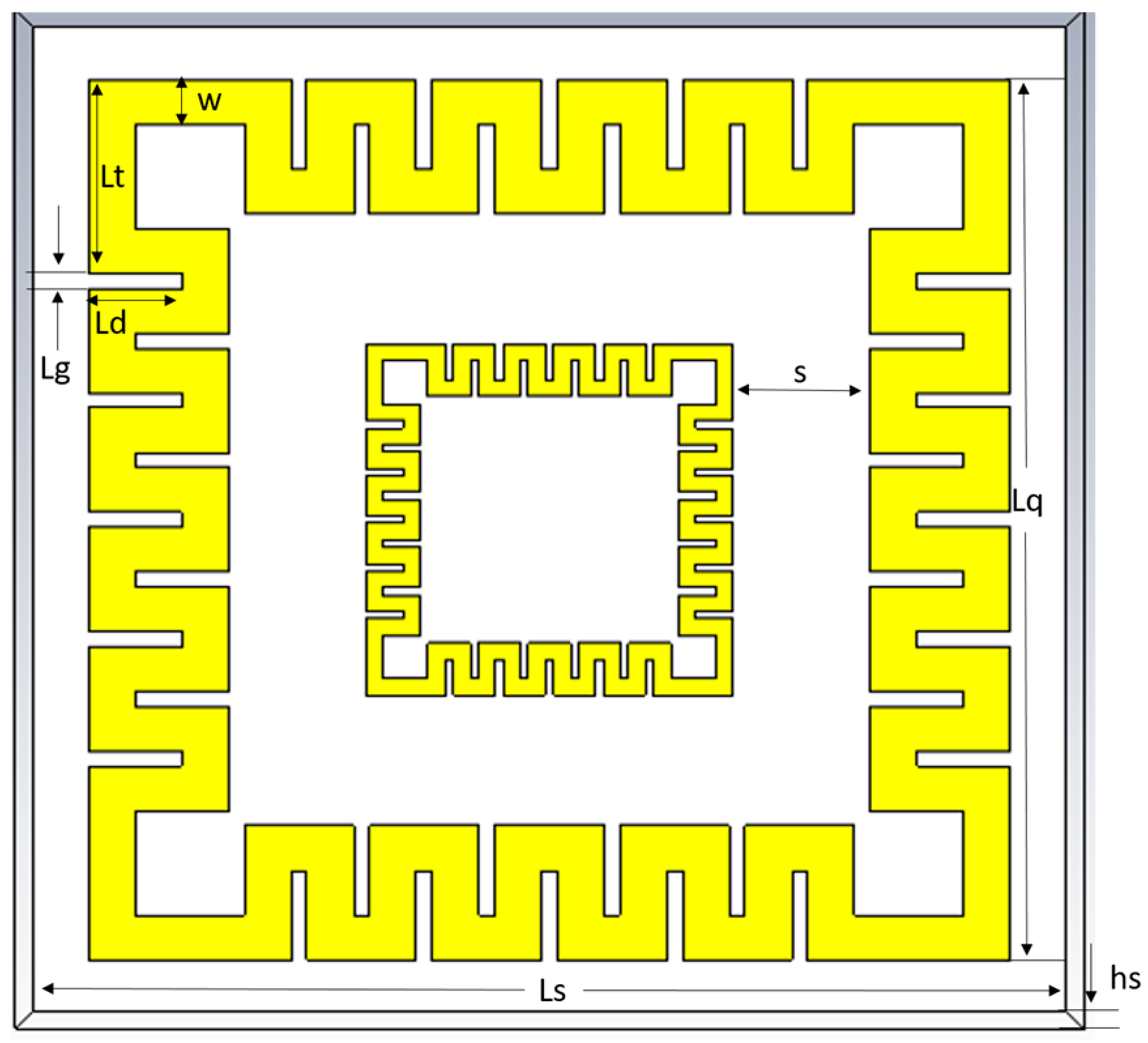

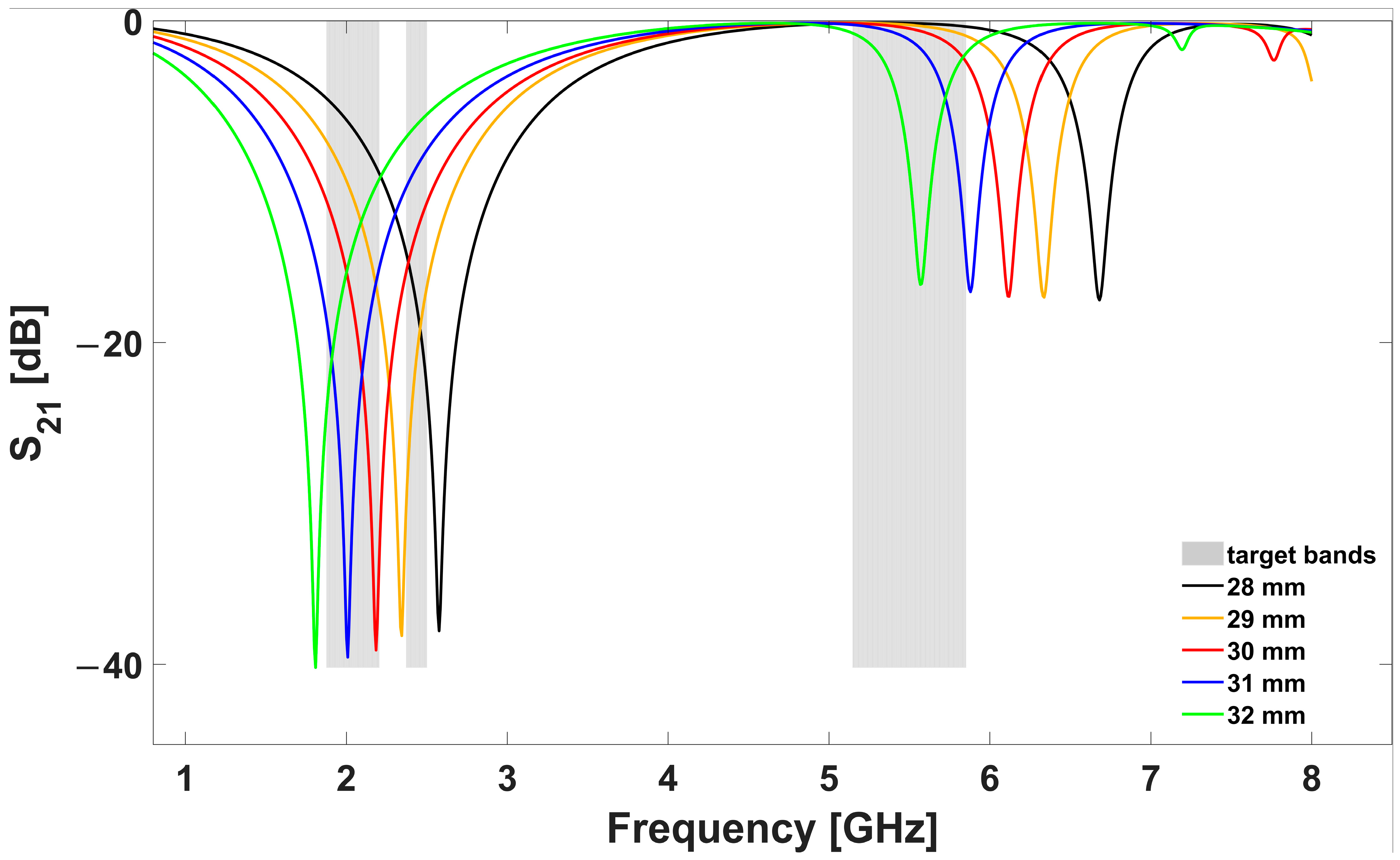
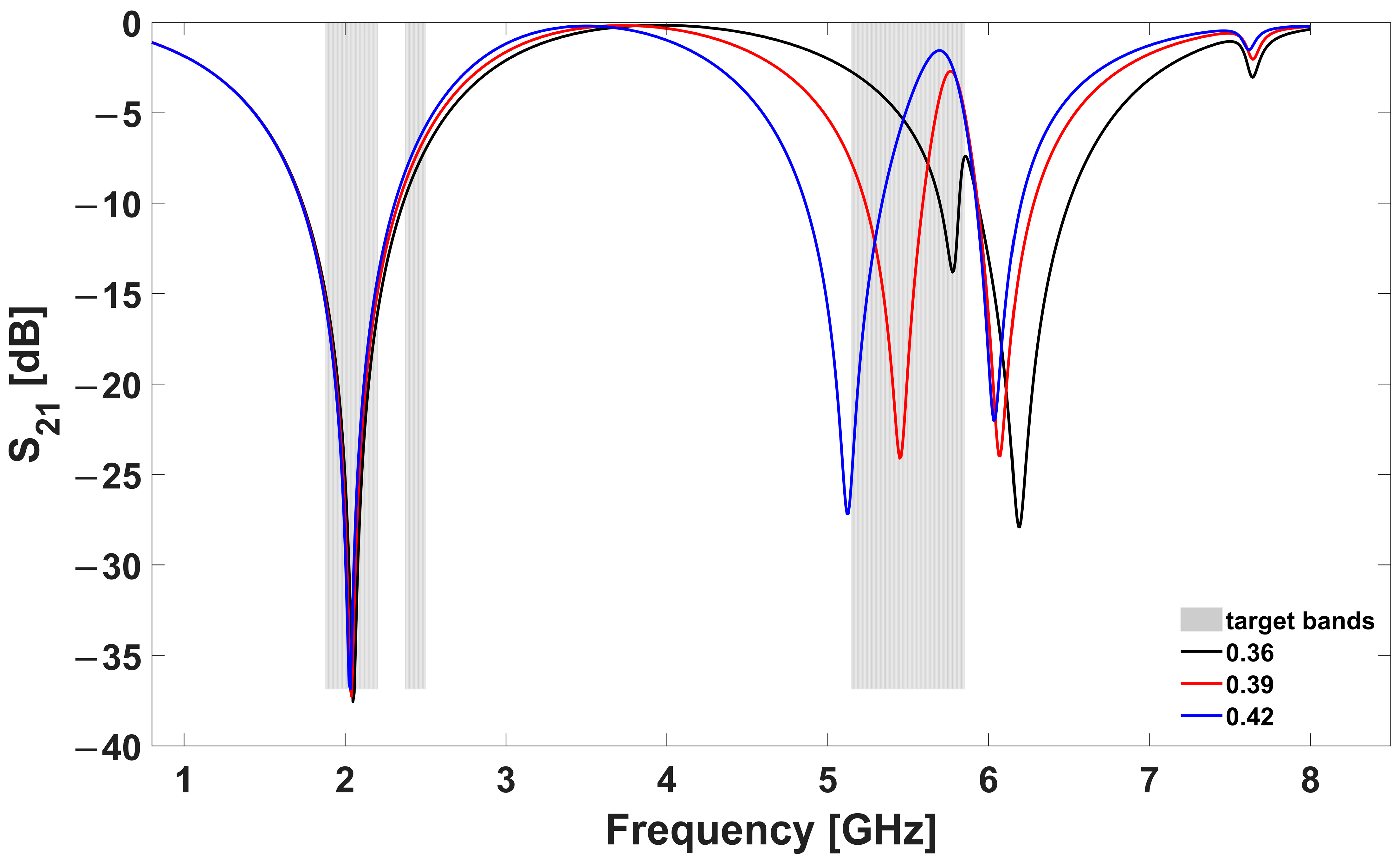

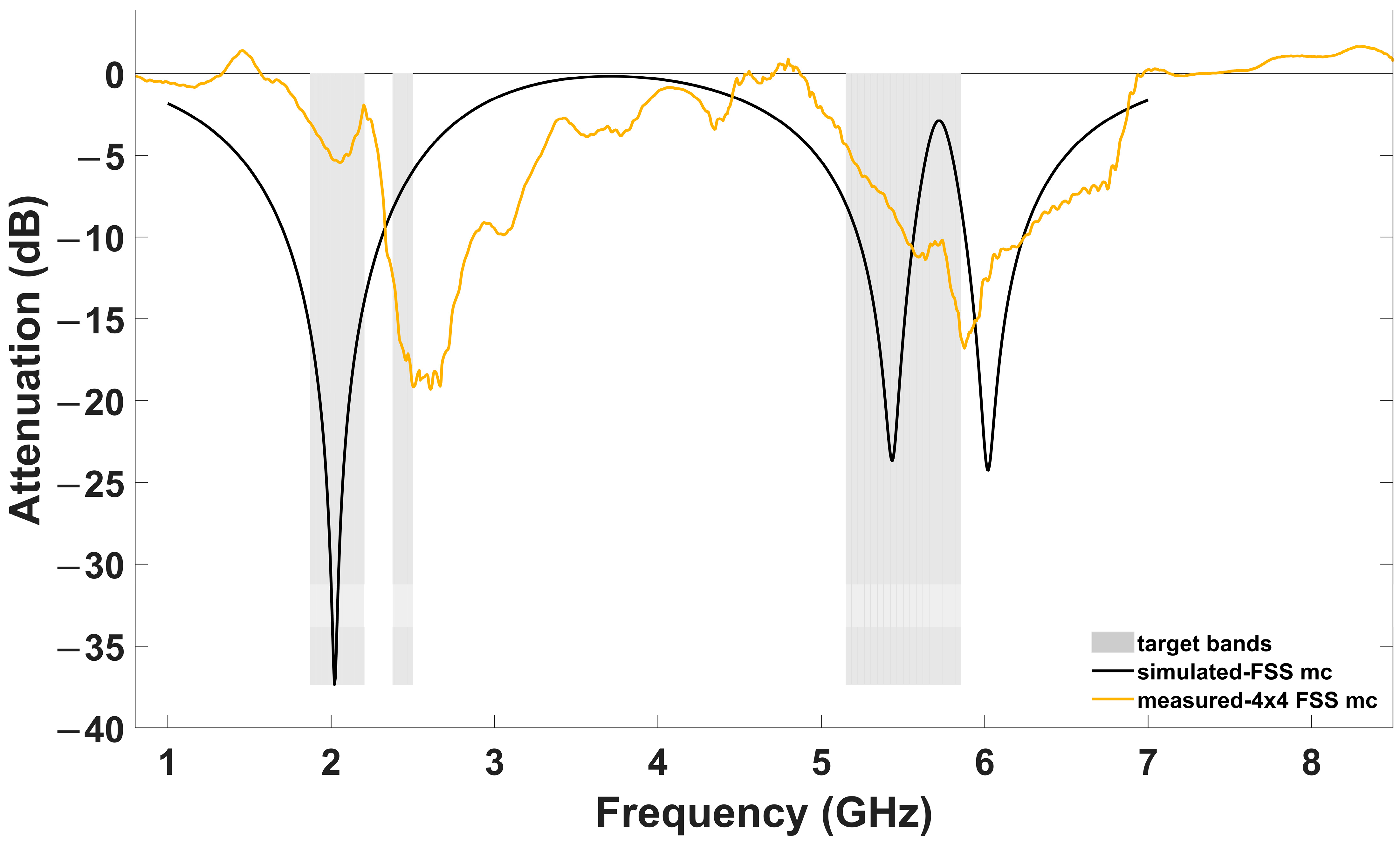

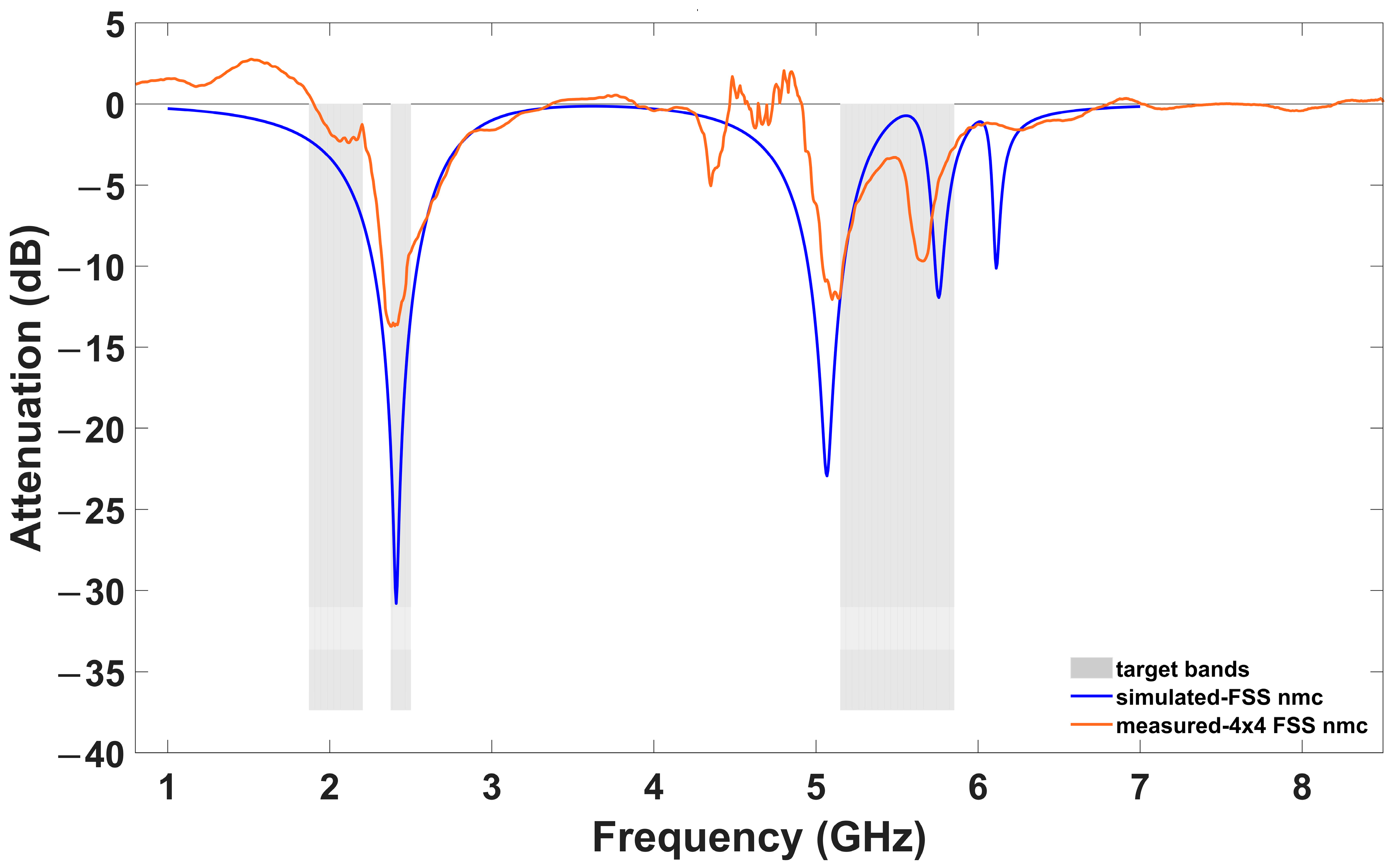
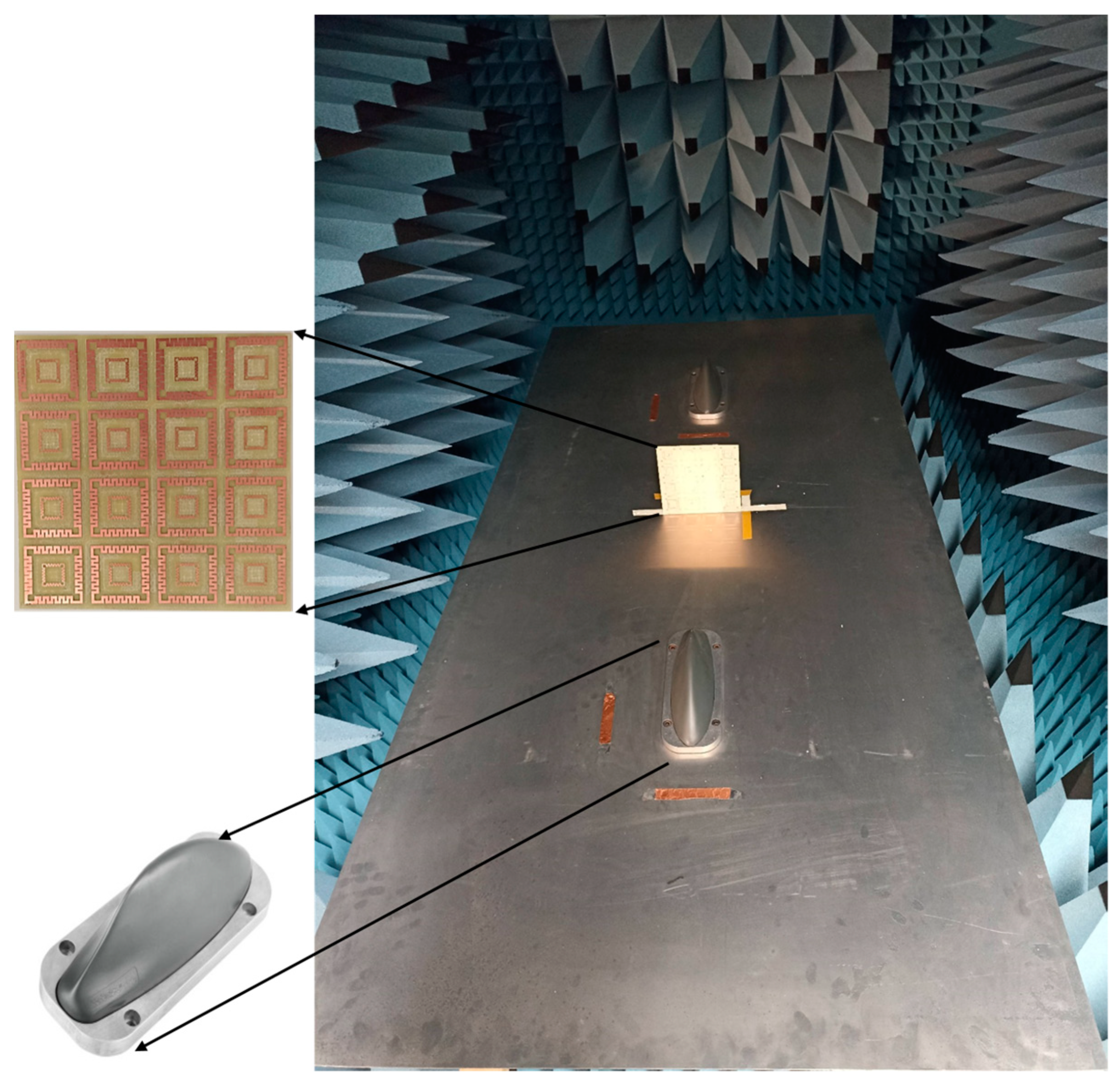
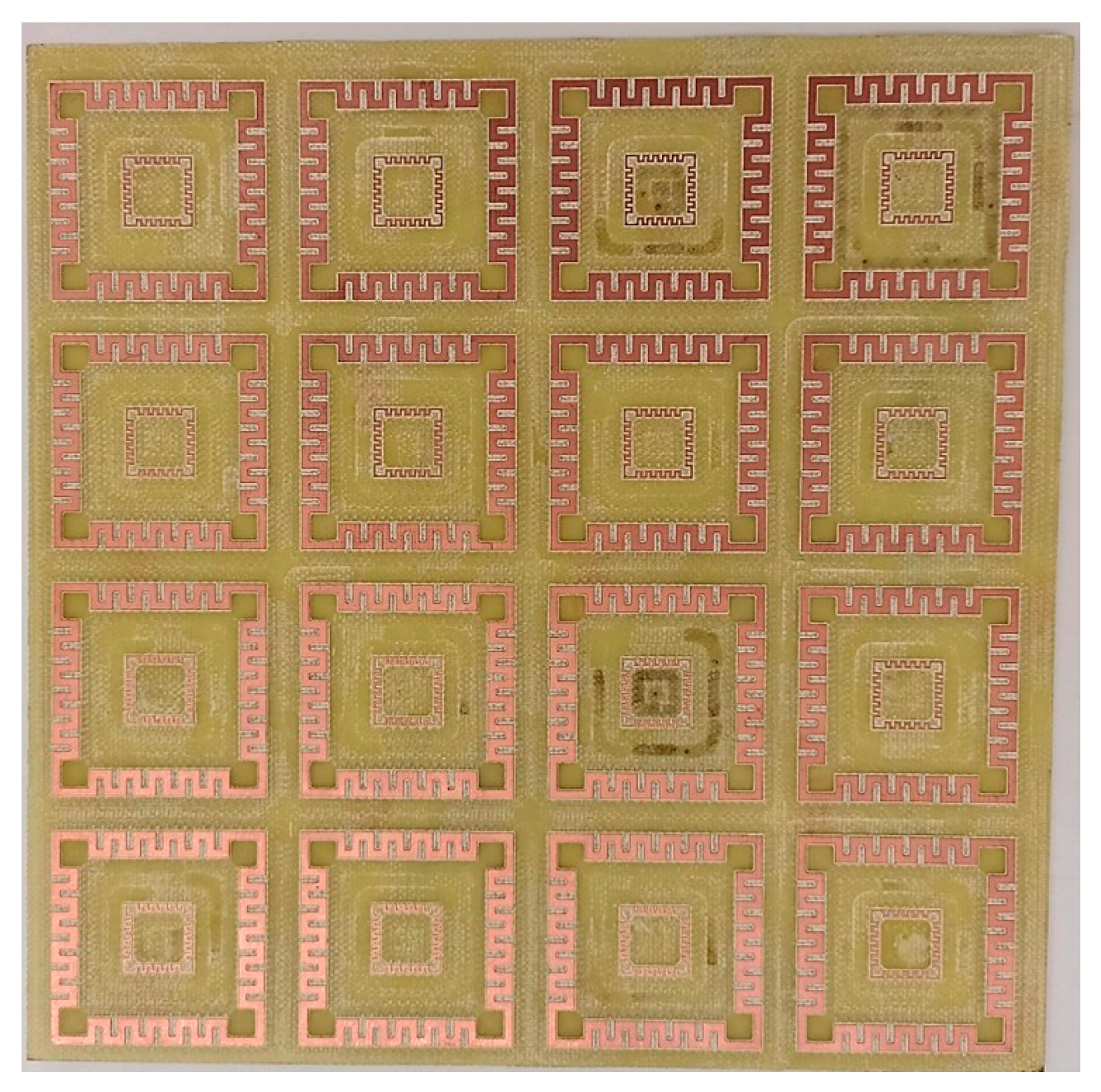


| Service | Freq. Band (MHz) |
|---|---|
| 3GPP | 1875–2200 |
| WiFi I | 2375–2500 |
| WiFi II | 5150–5850 |
| 4 × 4 FSSscaled | Dimensions (mm) |
|---|---|
| Ls | 42 |
| hs | 0.8 |
| w | 1.5 |
| Lq | 34.8 |
| Lt | 9.24 |
| Lg | 1.2 |
| Ld | 3.6 |
| s | 9.12 |
| d | 7.2 |
| Unit Cell Design | FSS Size | Isolation | Bandwidth | Remarks | Ref. |
|---|---|---|---|---|---|
| Interdigitated | 4.1λ × 4.1λ | 12 dB | 3.2–3.7 GHz | single band operation, narrow bandwidth, composite low-loss substrate, complex design | [21] |
| Square ring | 3.5λ × 3.5λ | 20 dB | 3.5–4.9 GHz | single band attenuation, cross-polarization discrimination (XPD > 20 dB) | [26] |
| Two-layer Double Split Ring Resonator (DSRR) | 1.058λ × 1.058λ | 30 dB | 915 MHz | narrow bandwidth, mismatch between simulation and measurement | [20] |
| Square single loop | 0.58λ × 0.316λ | 20 dB | 0.6–1.4 GHz | single band operation, double side FSS structure, simple design | [4] |
| Meander Square Nested Resonator (MSNR) | 2.31λ × 2.31λ | 6 dB | 1.875–2.5 GHz and 5.15–5.85 GHz | compact size, dual-band operation, dual-polarization, stable to angle influence | [this work] |
Disclaimer/Publisher’s Note: The statements, opinions and data contained in all publications are solely those of the individual author(s) and contributor(s) and not of MDPI and/or the editor(s). MDPI and/or the editor(s) disclaim responsibility for any injury to people or property resulting from any ideas, methods, instructions or products referred to in the content. |
© 2023 by the authors. Licensee MDPI, Basel, Switzerland. This article is an open access article distributed under the terms and conditions of the Creative Commons Attribution (CC BY) license (https://creativecommons.org/licenses/by/4.0/).
Share and Cite
Estévez, A.; Pérez, N.; Valderas, D.; Sancho, J.I. Low-Profile FSS Design Methodology to Increase Isolation between Vehicle-Borne Multifrequency Antennas. Appl. Sci. 2023, 13, 4187. https://doi.org/10.3390/app13074187
Estévez A, Pérez N, Valderas D, Sancho JI. Low-Profile FSS Design Methodology to Increase Isolation between Vehicle-Borne Multifrequency Antennas. Applied Sciences. 2023; 13(7):4187. https://doi.org/10.3390/app13074187
Chicago/Turabian StyleEstévez, Ailyn, Noemí Pérez, Daniel Valderas, and Juan I. Sancho. 2023. "Low-Profile FSS Design Methodology to Increase Isolation between Vehicle-Borne Multifrequency Antennas" Applied Sciences 13, no. 7: 4187. https://doi.org/10.3390/app13074187






